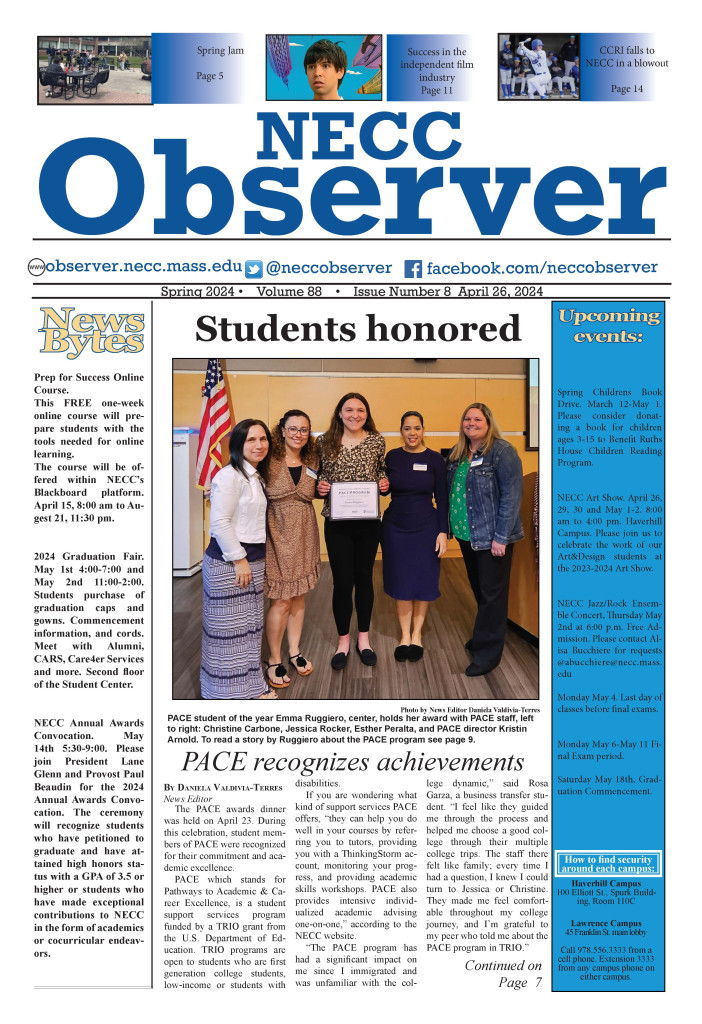On Thursday Oct. 20, during STEM week, on the Haverhill Campus in the Technology Center building a talk was held on the Science of Music with physics
professor J. Oscar Azaret with NECC chemistry student Lindsey Fevry.
In this talk Azaret discusses how Art, Science and Craft combined creates the classical guitar, the predecessors of guitars, the kinds of woods and the harvesting of
the woods used to create the guitars we know today, how these woods affect the musical instrument artists use as their tool, and the science behind the guitar.
The talk began just a few minutes before 1pm with Azaret making sure his guitar was tuned right and strumming along. He quoted Pete Seeger, “‘you spend half the time
tuning the instrument and the other half playing it out of tune.”
He soon began with his talk, discussing the origin back to the 8th century, to the creation of the classic guitar we all know today in the 1800’s, created by Antonio Torres Jurado. Next, Azaret spoke of the kinds of woods guitars are made of and how things are. Like, for example the fretboard, neck and soundboard when all brought together influence the overall sound
of a guitar if you listen closely. After, to demonstrate the difference he plucks Pedro Aguiar’s “Se ela perguntar” beautifully. With Azaret’s explanation you can find the key
note differences in the three examples he showed with three different guitar’s he had made himself.
With the help of Lindsey Fevry, NECC chemistry major student Azaret began exhibiting the science behind the classic guitar. With linear density, string tension, the
velocity of string vibration, and the resonant modes of string are some of the smaller pieces behind what makes your favorite guitar solo special. Music sounds different to everyone and speaks different volumes or tones to different individuals everywhere.
Azaret used a device called a sinusoidal flapper so you can see, visually how sound waves are affected by tension- like string tightening on a guitar, which brings up the frequency, vibration, and weight. To find the resonant modes of the frequencies you hear when listening to guitar takes three different equations.
To find the linear density it is the mass over the length of the string. To find the string tension with the mass found prior times gravity.
Next, to find the velocity of the string vibration takes the square root of the tension over the linear density-meaning the speed of the vibration of a string. Lastly, to find the resonant modes members of the audience had to figure out what frequency would come next and Azaret then demonstrated the Hz on the sinusoidal flapper made in his class.
“The whole point of this board is because we are trying to calculate the frequency of the resonant modes…the way that one person resonates well with another is because they fit together… with this board it explains what frequency works best or ‘gets’ each other well enough to find the mode” says Fevry, who was given the opportunity to present the math explained because of how well she had presented a similar topic in her physics class with Azaret. “
The way he (Azaret) presents this topic makes it interesting and important because it explains the ‘why’ and how this all connects to life in some manner, it makes you look at the grand scheme of things while learning.”
Not only is Azaret a physics and engineering professor but he is also a luthier and Executive Director of the Boston Classical Guitar Society.
Before teaching at NECC in 2012 Azarat was a mechanical engineer at Bell Laboratories for three decades in the Boston Area. His passion for
guitars began in ‘94 and now he makes them. If you would like to have a guitar handmade or to discover your voice you can get more information on this at www.azaretguitars.com .
When asked why he thought the topic of the science behind the sound of guitars are important Azaret said “I think it’s important because, it’s important to stretch your
thinking and look underneath the surface of things and try to integrate together the different contributing factors of things….if you see a guitar you look at it as it is but you don’t think about the history of guitar and how it has. evolved, you don’t think about what it takes to build a nice guitar…it’s important for people to look beneath the surface and see all the contributing factors’.”

